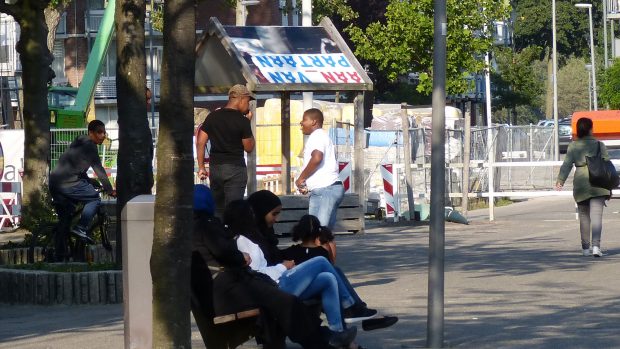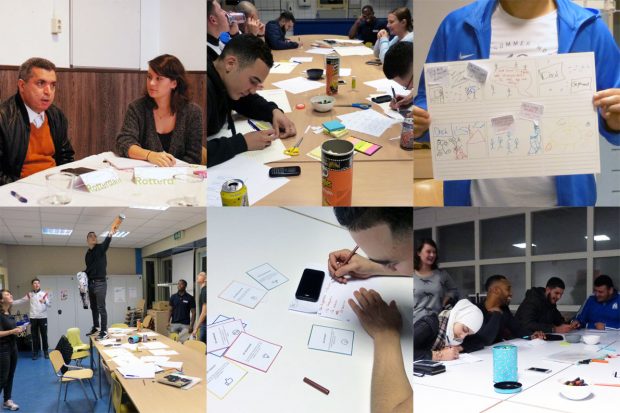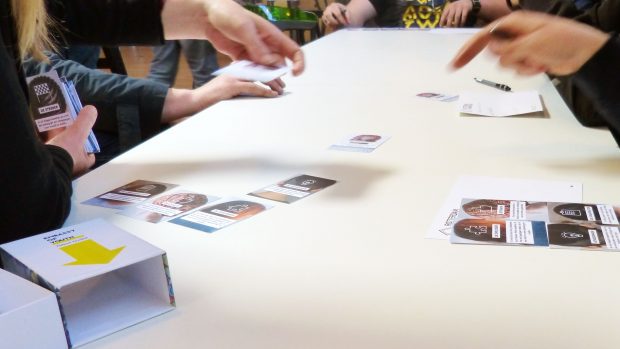By Lisa Van de Merwe
Empowering urban youth to explore and use their talents.
Teenagers hanging out on the streets are often assumed to be up to no good. However, their behavior might be misinterpreted. Being outside together is valuable to them and important in order to bond; to have their own place where they get to represent and explore who they are, without the context of home, school or work. They feel as a part of the streets and the streets are a part of their identity. It is their safe place; their Embassy.

(Fig 1: Teenagers in Feijenoord, Rotterdam.)
The negative perspective from the outside world influences how the youngsters see their own capabilities. Especially teenagers from a disadvantaged neighborhood can feel limited in realizing their dreams. This is why I set up the project ‘Embassy of Youth’ together with Oxfam UK and DIOPD, to investigate how I could design for these teenagers instead of against them. I wanted to get to know them, understand their motives and investigate how design can be used to enhance their well-being as well as their neighborhood’s.
(A short compilation of a Dutch tv programme about urban youth in Rotterdam South and their perspectives.)
Stories worth sharing
I focused my research on one specific neighborhood in Rotterdam, called Feijenoord. I got to know the area and the teenagers by approaching youth work organizations, attending local events, interviewing locals on the street and setting up co-creation sessions with teenagers (mostly boys). It uncovered many positive and inspiring stories from the neighborhood; stories that are worth being shared to inspire the youngsters and to create empathy from the community towards them. However, it also exemplified that these boys have so much to say, but do not feel heard or taken seriously by their surroundings. They feel that they are bound to fail. So how can we as designers intervene here and create positive change?

(Fig 2: Co-creation sessions and focus groups with teenagers and other locals.)

(Fig 3: A workshop about ‘talent’ with teenagers in Feijenoord, Rotterdam.)
Expression of identity through talents
Since expressing identity is an important part of discovering who you are, I wanted to provide a more meaningful and beneficial way for the teenagers to express it: through their talents. I wanted to show others the talents these teenagers have and, most importantly, show the teenagers themselves. In order to achieve that, I designed the ‘Talent toolkit’.
“I wanted to show others the talents
these teenagers have and, most importantly,
show the teenagers themselves.”

(Fig 4: The Talent toolkit.)
A tool for youth organizations
The Talent toolkit can be used by youth work organizations to host a series of workshops. In three steps, the teenagers discover (1), develop (2) and reflect on (3) their own and each other’s talents. It includes group exercises and discussions based on 15 different ‘Talent cards’ such as ‘The leader’, ‘The storyteller’ or ‘The coach’.

(Fig 5: The Embassy of Youth platform, discussion cards and the workshop in progress.)
These cards help them to understand what talents are, it provides a language to describe them and triggers them to discover their own. The cards show (anonymised) photos and quotes from local heroes of the neighborhood, such as local rappers and entrepreneurs but also the next-door neighbor. The identities of these local heroes are revealed on the ‘Embassy of Youth’ website, a platform filled with examples of where your talent can take you. This website also shows ‘outsiders’ the stories beyond what is perceived on the streets.

(Fig 6: Discussing the meaning of different talents is an important part of the workshop.)
Inspiring confidence and a positive perspective on the future
In the workshops, it is not about the teenagers finding their perfect set of talents, since they are still young and discovering who they are. Rather it is about realizing that they have talents in the first place and that they can do something with it. The workshops provide confirmation of that through discussions and compliments from others. It stimulates positive thinking and makes teenagers feel more confident and aware of their talents, creating motivation to turn them into actions that can contribute to their own well-being and that of the neighborhood.

(Fig 7: ‘Embassy of Youth’ poster in the neighborhood.)



